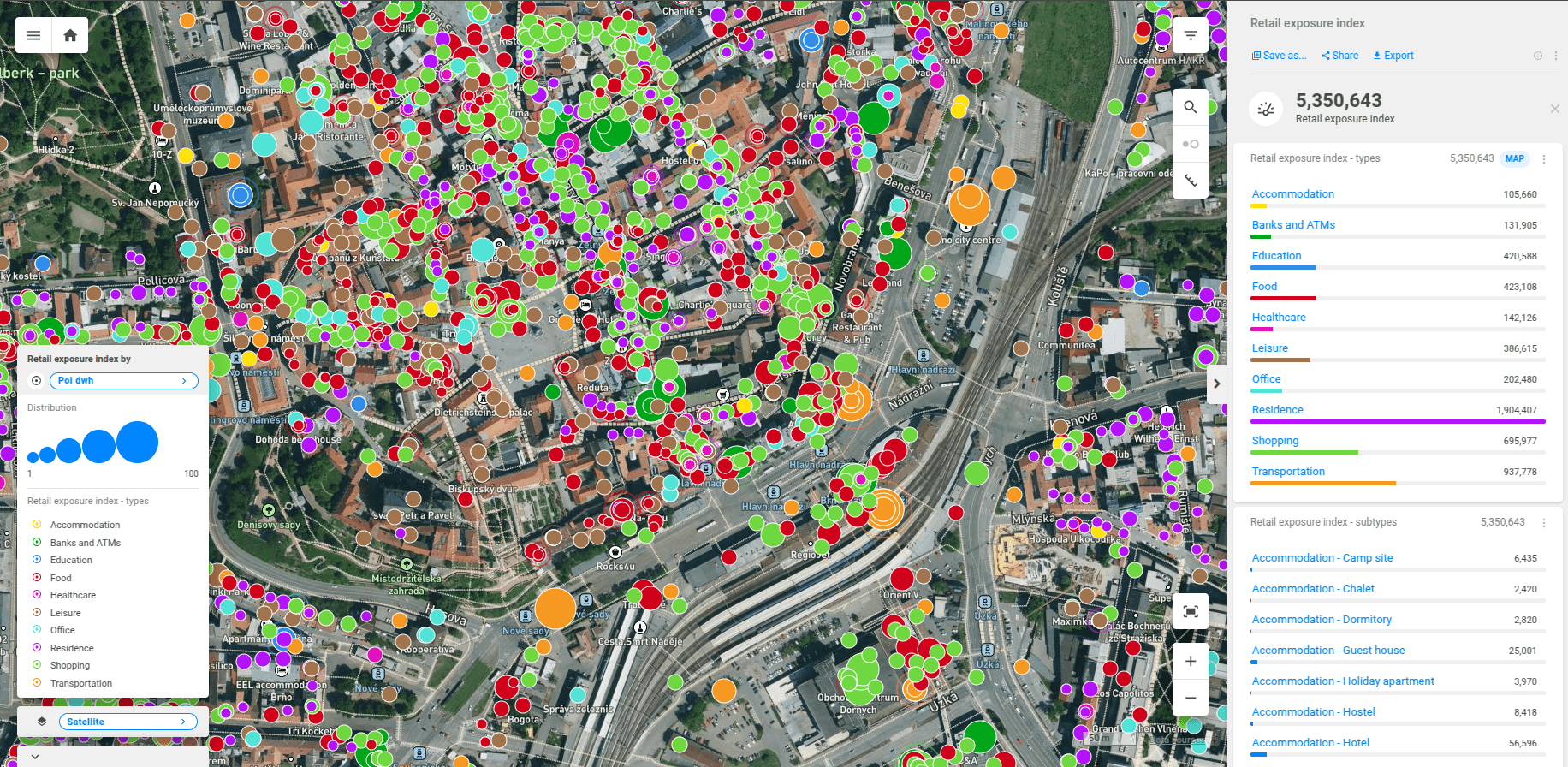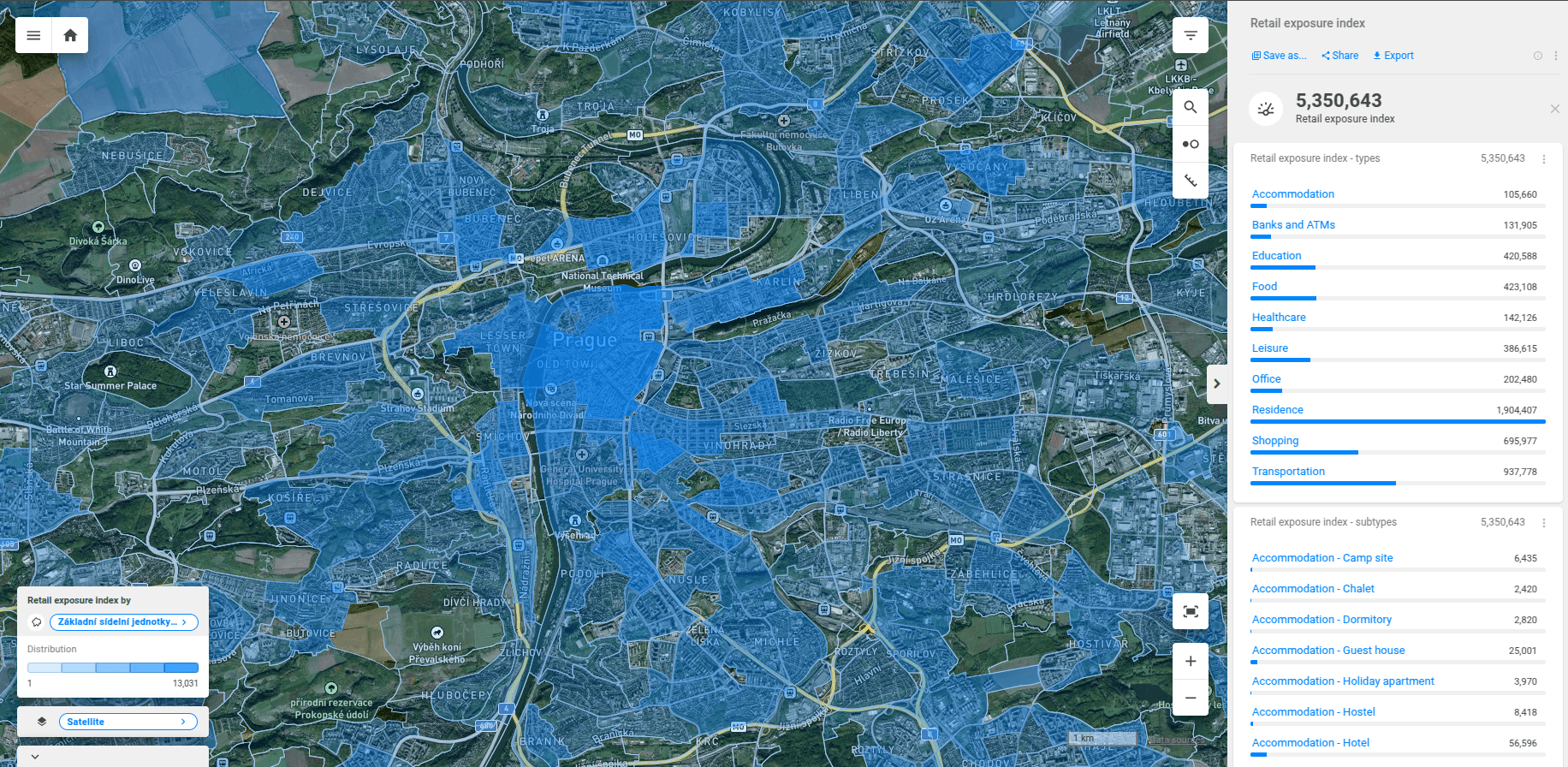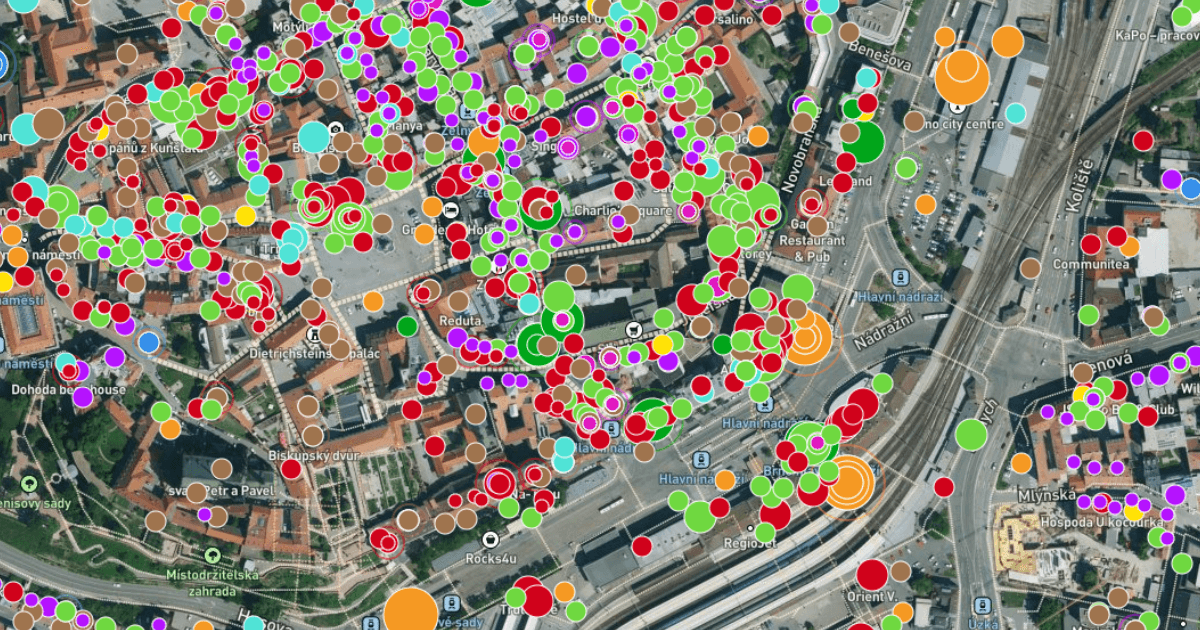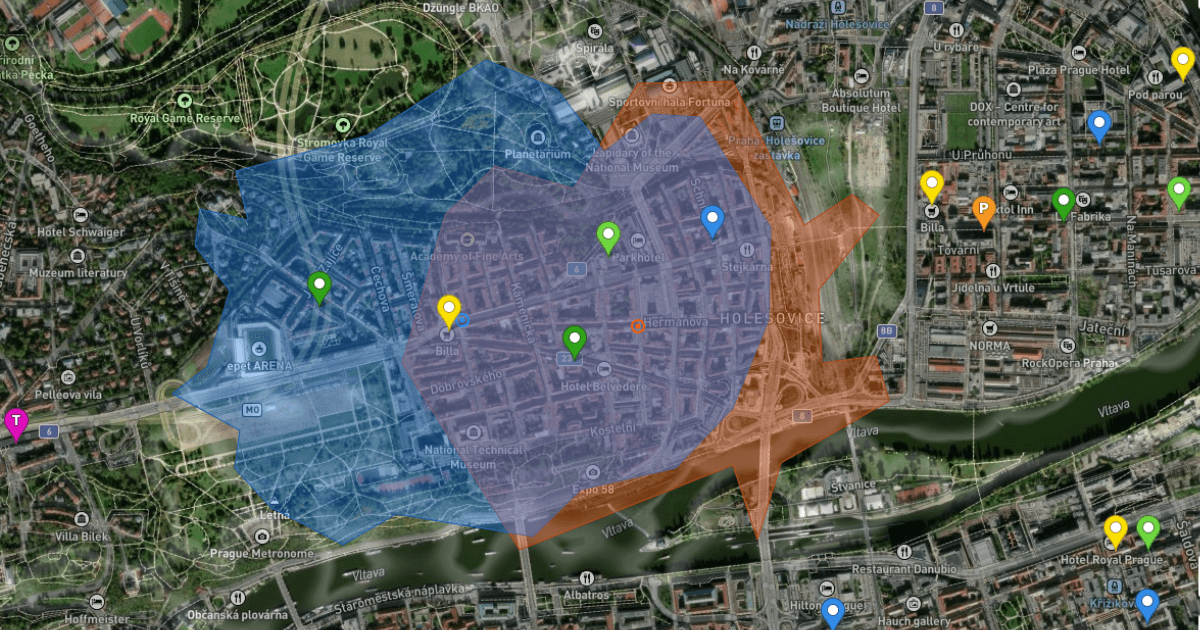
Ondrej Hubacek
SOLUTIONS
8 MINS READ
How to Measure the Attractiveness of Your Business Location
What are the key factors when choosing a business location? Learn how to measure location attractiveness with data tools and make better decision.
In a world where data is growing so fast and competitors are gaining an edge through “data-driven decisions,” relying solely on intuition without utilizing data is no longer a viable strategy. Using data not just as a validator of intuitive thinking but as a foundation for decision-making has become essential. Fortunately, modern data tools are more accessible and affordable than ever, making it easier for businesses to adopt a data-driven approach. Let’s explore the tools you can use to effectively measure the attractiveness of a location.
Why Location is Important in Business
One key area that businesses must focus on is spatial data and its relationships. Despite the rise of digital platforms, most activities still occur in the physical world, making business location a critical factor. Choosing the right location is one of the most impactful decisions for any business, making location important for attracting talent, connecting with clients, and ensuring operational success. Whether opening a new retail store, placing parcel lockers, or expanding a restaurant chain, understanding the surrounding environment is essential for success.
Among the many data tools available, Points of Interest (POI) data stands out as a fundamental resource. Tools like the Retail Exposure Index use POIs to provide actionable insights, helping businesses identify attractive locations and optimize strategies.
What is the Best Location for a Business?
The best location for your business depends on factors such as industry, target audience, and operational needs. Certain industries, particularly in retail and hospitality, have unique location needs based on their operational nature.
Good public transport links are essential for ensuring accessibility for both clients and employees. Proximity to Points of Interest, such as transit hubs, shopping centers, and parking facilities, is crucial for ensuring accessibility and visibility.
For example, a retail store benefits from high-foot-traffic areas, while logistics centers thrive near major transportation routes. Evaluating these factors ensures the location aligns with your business goals.
Evaluating the Right Business Location
Evaluating the right business location involves considering several key factors to ensure it meets your operational and strategic needs. Affordability is a primary concern; the location should balance operational costs with potential business revenues. Accessibility is another critical factor, ensuring that customers, employees, and suppliers can easily reach your business.
The image and prestige of a location can also impact your business, especially if your brand relies on a certain level of status. Demographics play a significant role, as understanding the local population’s age, income, and preferences can help tailor your offerings.
Proximity to other businesses and services can create synergies and attract more customers, while the potential for growth ensures that the location can accommodate your future expansion plans. Additionally, the location should meet your specific business needs, such as having a reliable internet connection and adequate transport links.
What is an Example of a Good Business Location?
The ideal location varies depending on the type of business. High-street locations are particularly advantageous for retail businesses due to their visibility and customer accessibility. The local area can significantly influence the suitability of a business location, as nearby businesses and services can generate beneficial traffic and attract potential employees.
For instance, a strategic location for a parcel locker network would be near a supermarket and a bus station. This placement ensures convenience for both shoppers and commuters, maximizing usage and efficiency. Such examples highlight the importance of aligning your location with your business type and customer needs.
How to Choose a Site Location Strategically: Key Business Location Factors
Selecting a site location requires careful analysis of key factors and an understanding of the key benefits. Here are five critical steps to consider:
Study Demographics: Assess the population in the area, including factors like age, income, and purchasing power, to ensure alignment with your target market.
Analyze Your Target Audience: Understand customer behaviors, preferences, and habits to determine how they interact with the location.
Evaluate POIs: Ensure proximity to relevant landmarks like shopping centers, transit hubs, or parking facilities to maximize accessibility.
Assess Competition: Analyze nearby competitors and evaluate whether the market is oversaturated or has room for growth.
Consider Operational Needs: Check for essential infrastructure such as utilities, gas pipes, internet, and space availability to meet your business requirements.
Where can you find data for assessing a business location? Check out our Data Marketplace.
Business Location Strategy
A business location strategy is a comprehensive plan to find the best location for your business to achieve its goals and objectives. This strategy involves analyzing different locations and evaluating their pros and cons based on various criteria. A well-crafted business location strategy considers your target market, competition, and operational requirements.
When developing a business location strategy, it’s essential to think about the long-term implications of your decision. Consider how your business will grow and evolve over time, and choose a location that can accommodate your future needs. This might involve looking at scalability, flexibility, and expansion options. For instance, a location with ample space and favorable zoning laws can support your business as it expands.
By taking a strategic approach to selecting your business location, you can ensure that your choice supports your long-term success and growth.
Why Business Location Attractiveness is Key
A business location refers to the physical site where a company operates. For a retail business, the location is crucial as it can significantly impact growth and success. It plays a key role in shaping a company’s operations, finances, and ability to attract customers. A strategically chosen location enhances customer access, boosts foot traffic, and provides a competitive advantage.
However, a poorly chosen location can lead to reduced sales, higher operational costs, and lower overall performance. This highlights the importance of business location and why measuring its attractiveness is critical. Tools like the Retail Exposure Index provide quantifiable insights to guide businesses in making informed, data-driven decisions.
What Are Points of Interest and Why Do They Matter?
Points of Interest (POIs) are more than just locations on a map—they are dynamic activity centers that influence human behavior, accessibility, and market opportunities. From crowded retail centers to critical transit hubs, POIs provide businesses with data to identify the best places of business.
10 Reasons Why POIs Are Essential When Finding the Most Attractive Business Location
Help predict foot traffic and identify high-demand areas.
Provide insights into customer behavior, revealing habits and preferences.
Enhance location selection by offering data on proximity and accessibility.
Support competitive analysis by highlighting nearby competitors.
Drive targeted marketing campaigns by pinpointing high-traffic areas.
Predict trends and opportunities by identifying emerging patterns.
Provide demographic insights for audience-specific strategies.
Offer data on economic characteristics and prevalent business types.
Include information about nearby businesses for networking and outreach.
Highlight opportunities for new business locations, uncovering market gaps.
Why Retail Exposure Index Helps Find the Best Location for a Business
The Retail Exposure Index is a dataset derived from Points of Interest (POIs) that serves as a powerful tool for evaluating the potential of specific business locations. By aggregating and analyzing POI data, the Retail Exposure Index assigns weights to various location types based on their impact on customer flow and visibility.
High weights are assigned to locations such as shopping malls, transit hubs, and banks, which significantly influence customer traffic.
Medium weights apply to places like office buildings, gyms, or smaller retail stores that have a moderate impact on customer activity.
Low weights are given to places like parks, residential areas, and other locations with less direct commercial relevance.

The resulting scores identify areas with high exposure to potential customers, guiding businesses in selecting optimal locations or expanding to existing sites. Essentially, the Retail Exposure Index helps businesses understand the importance of location in business by evaluating the significance of any given place based on its potential commercial impact.
The dataset is built using multiple sources, offering high coverage while addressing challenges such as duplications, outdated data, and inconsistencies. To ensure accuracy and reliability, a thorough data-processing system is implemented.
Recognizing that POIs are constantly changing, the Retail Exposure Index is updated quarterly to reflect these shifts. This regular update process ensures that businesses can rely on up-to-date and dependable data to make informed decisions about their business location.
How CleverMaps Studio Helps Analyze Location Attractiveness
CleverMaps Studio, an advanced tool for Location Intelligence and Business Intelligence, provides an intuitive way to analyze the Retail Exposure Index. With its user-friendly interface and advanced analytical capabilities, CleverMaps Studio transforms data into actionable insights, making it an essential tool for businesses seeking the most attractive business location.
The studio offers a wide range of tools and visualizations tailored for Retail Exposure Index analysis, supporting diverse use cases. Let’s explore its possibilities:
1. Heatmaps
Color gradients: Visualize exposure levels with gradients—red indicates areas with the highest exposure, transitioning to green for zones with lower exposure.
Hotspot identification: Easily pinpoint activity spots and identify regions with untapped potential.
Time-based trends: Analyze heatmaps over time to track changes in exposure, identify trends, and respond to market shifts.
2. Dotmaps for Detailed Visualization
POI representation: Represent individual Points of Interest (POIs) as dots, providing a clear view of their distribution in the area.
Qualitative analysis: Categorize dots by color to represent different POI types (e.g., retail, transit, entertainment), offering insights into the composition of the area.
Quantitative analysis: Adjust dot sizes based on different metrics, such as exposure levels, to highlight areas of importance.
3. Aggregation on Polygons
Higher-level analysis: Use administrative units (e.g., city districts) or custom polygons to aggregate data and conduct analysis on a higher scale.
Custom regions: Create custom polygons to analyze data within specific zones, such as shopping districts, catchment areas, or delivery zones.
Opportunity spotting: Use aggregated exposure scores to identify underperforming or high-potential regions for expansion or new investments.

4. POI Inspection
Detailed information: Click on individual POIs to view details like address, category, and associated data.
Competitor analysis: Analyze nearby competitors by inspecting their POI details, giving you an edge in understanding the competitive landscape.
5. Attribute Filtering Options
Category-based filtering: Narrow your analysis by filtering POIs based on their main types (e.g., shopping or healthcare) or subtypes (e.g., supermarkets or ATMs).
Chain identification: Identify specific business chains or franchises within the dataset—useful for evaluating market saturation or potential partnerships.
Custom filters: Combine category filters with other metrics, such as exposure scores or demographics, to create highly targeted analyses.

6. Spatial Queries (Spatial Filtering)
Attribute and spatial filters: Explore spatial relationships, such as finding locations within a certain distance from key landmarks or transit hubs.
Travel modes: Analyze accessibility using buffers based on walking, driving, cycling, or flying distances, helping businesses evaluate how reachable a location is for different customer segments.
Catchment area analysis: Use spatial queries to define and analyze catchment areas, providing insights into customer accessibility and service reach.

7. Location Comparisons
Side-by-side metrics: Compare multiple locations by analyzing key metrics such as exposure levels or the number of nearby POIs.
Spatial query integration: Combine spatial queries with metrics to define and evaluate selected locations.
Aggregated metrics: Compare aggregated data, such as exposure scores or total POIs, within defined areas to determine the most attractive business location.

Business Location Attractiveness Matters for Success
The importance of business location attractiveness cannot be overstated. By considering factors such as proximity to POIs, accessibility, and demographic alignment, businesses can make strategic decisions that drive success. Tools like the Retail Exposure Index and CleverMaps Studio provide actionable insights for identifying the best places of business.
For more insights, explore our previous articles:
How to Get the Most Out of Point of Interest Data for Location Analysis
Retail Exposure Index: Your Guide to Optimal Business Expansion
Ready to explore the best location for your business? Request a demo today!





